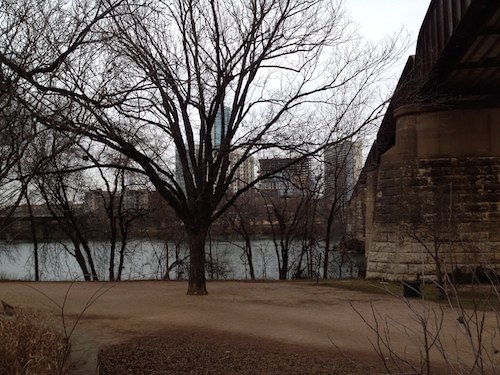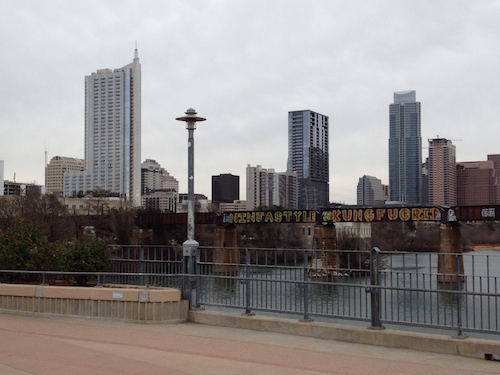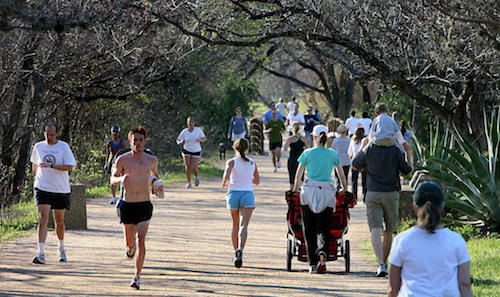
(Image Credit: Jay Voss)
If we’re to think about landscapes in Austin, it only makes sense to start with something in the very heart of the city. What immediately comes to mind, of course, is the Lady Bird Lake Hike and Bike Trail. This jogging path encompasses over 10 miles of mostly flat jogging track that weaves its way around and over Lady Bird Lake. It has proved to be an enormously popular place for Austinites to escape their concrete jungle. Go down to the area for an evening workout in the warmer months, and the trail will be so packed with joggers and walkers you’d wish you’d braved the midday heat. I’ve long thought all this activity around the lake to be one of the more inspiring aspects of living in Austin. There aren’t really any other cities that I can think of that offer up swaths of seemingly undeveloped land for outdoor recreation. Sure, there’s that stretch along Lake Michigan in Chicago, or along the quays in Paris, but nothing quite compares. The architectural thinking behind the Austin trail is completely focused on getting Austinites out and about, and given that the city is otherwise obsessed with finding all sorts of comfort via technological progress, I think the hike and bike trail is really admirable.

(Image Credit: Jay Voss)
What we now call Lady Bird Lake first started taking shape in 1939, when the Tom Miller Dam was constructed on the Colorado River. This dam was primarily built to provide hydroelectric power for the surrounding area. In 1960, the Longhorn Dam was built east of Austin, and this created what would eventually be called Lady Bird Lake. According to the Texas State Historical Association, the lake was created for two reasons: that the Holly Street Power Plant might have a cooling pond, and that the city might have a new recreational space. By 1970, the lake had become polluted, and its shores covered with weeds. It was then that Mayor Roy Butler teamed up with Lady Bird Johnson to establish the Town Lake Beautification Committee, which worked to transform the lake into a non-polluted recreation area and install the hike and bike trails that are the subject of this post. This makes the Lady Bird Lake Hike and Bike Trail one of the oldest tracks of its kind in the United States.

(Image Credit: austin360.com)
It’s amazing to think that one of the more modern architectural facets of Austin is really 40 years old. I’ve talked to landscape architects from Oregon to Georgia, and several of them have at least one project like this on their docket. From a civic planning standpoint, these trails make a lot of sense. They work to keep intensely urban areas vibrant and youthful, and they encourage healthy lifestyles for citizens (which encouragement has a number of economic incentives). Visiting Town Lake and its adjacent outdoor recreation, you could of course complain how insanely artificial the entire landscape is from a BBC Planet Earth perspective. The “lake” might be said to look more like a stereotypical river, and there’s no telling if the surrounding vegetation was really that lush before the Colorado River flooded its banks.
But I say, at the end of the day, Lady Bird Lake and its surrounding area are just as invasive as the gardens at Villa Farnese and Versailles. I suppose that comparison doesn’t justify the environmental alteration that is Lady Bird Lake, but it sure does remind us that the new landscape is much more satisfying than all the glass and steel that sits behind it.



Recent comments
2 years 29 weeks ago
2 years 44 weeks ago
2 years 44 weeks ago
2 years 50 weeks ago
3 years 4 weeks ago
3 years 4 weeks ago
3 years 4 weeks ago
3 years 6 weeks ago
3 years 6 weeks ago
3 years 6 weeks ago